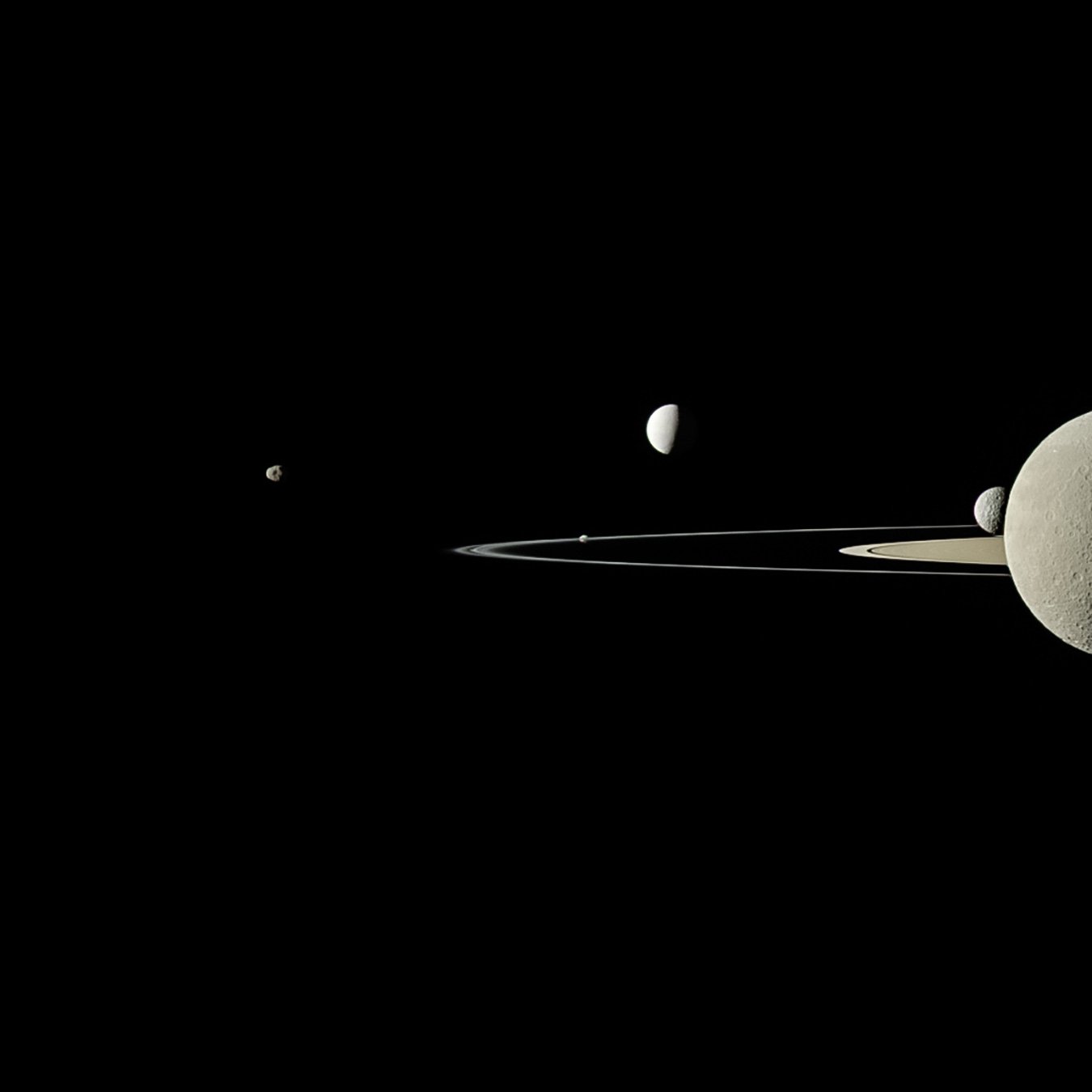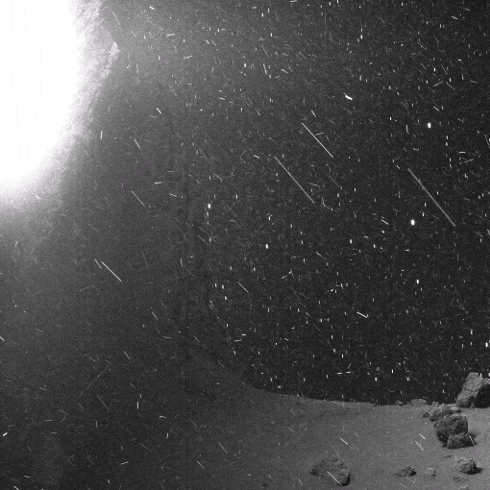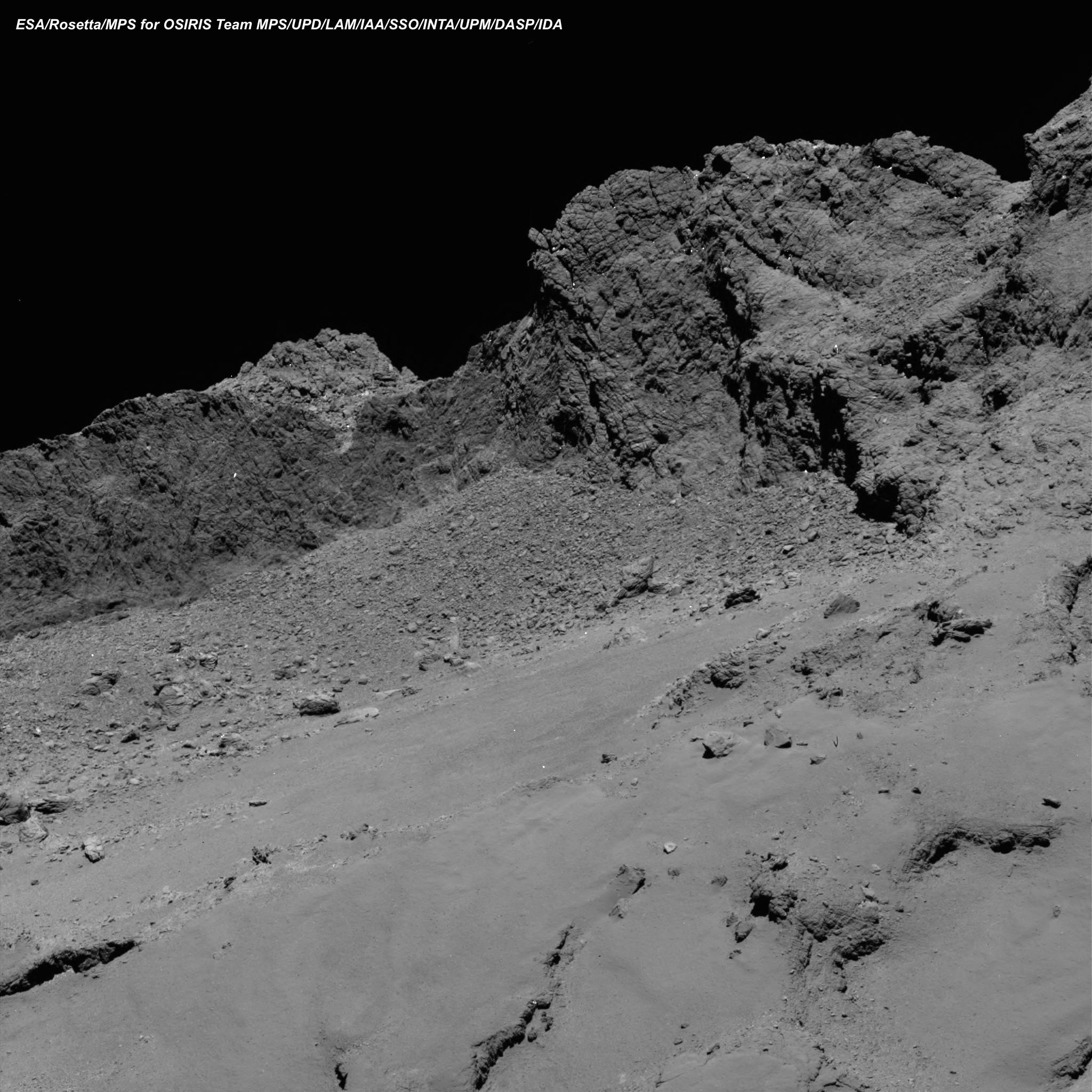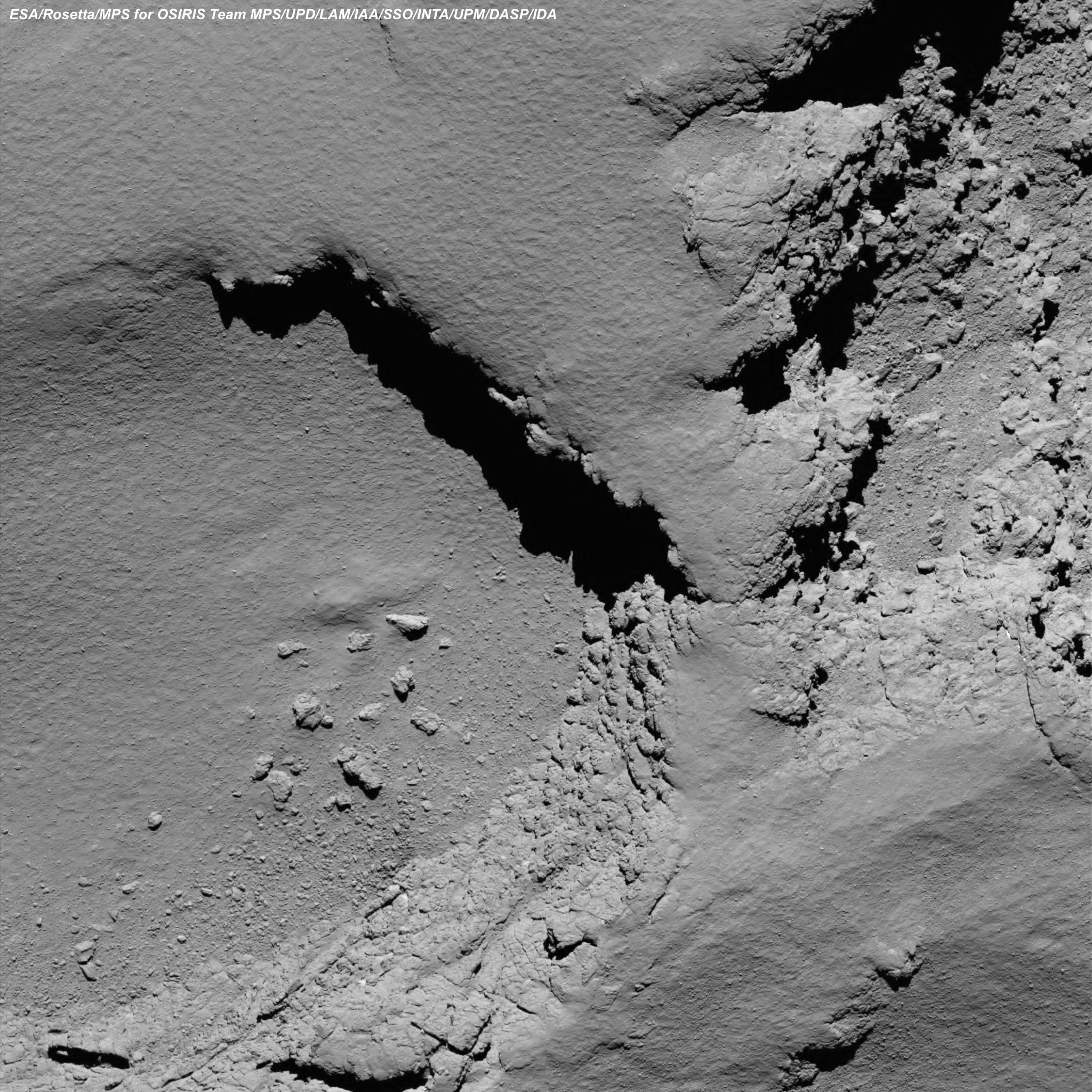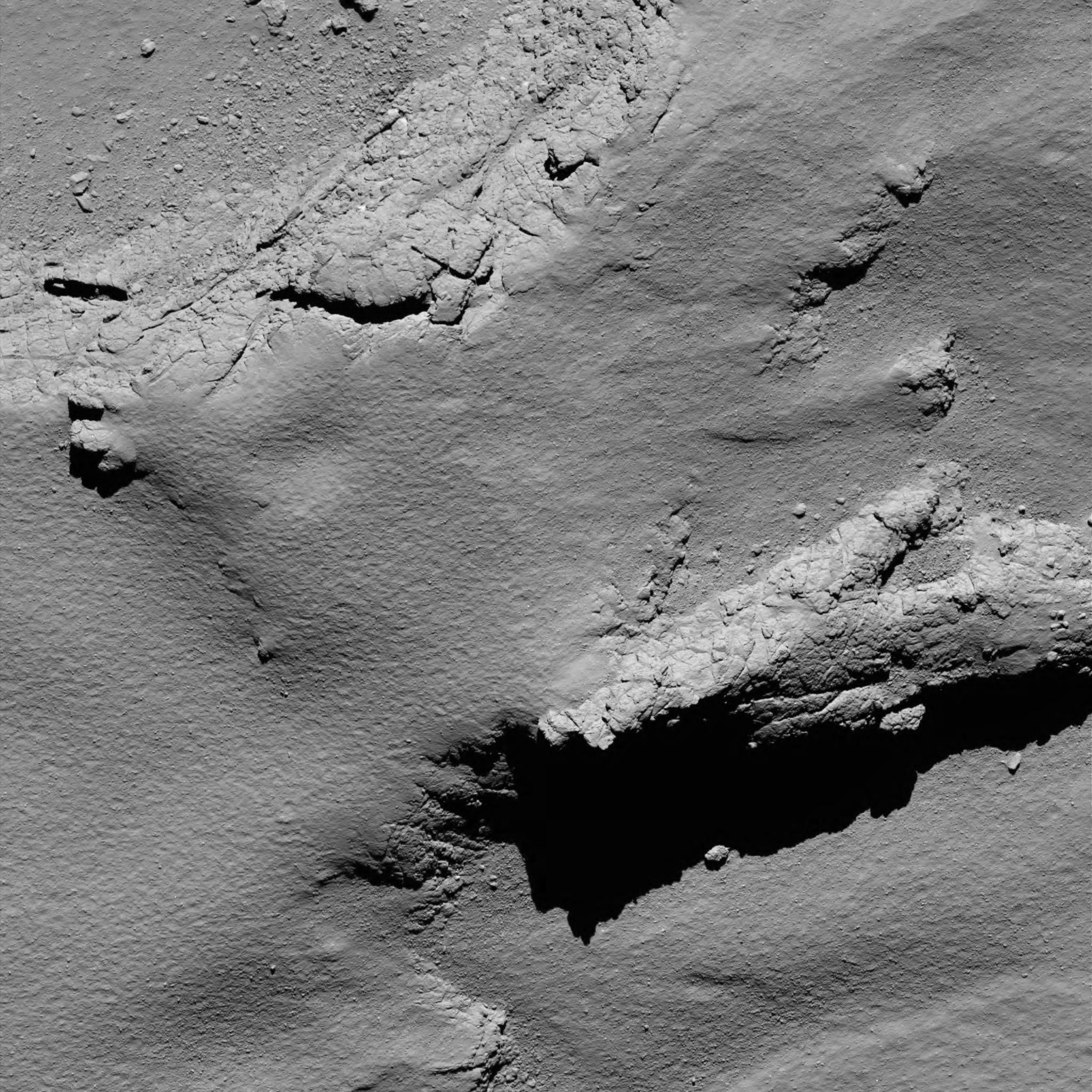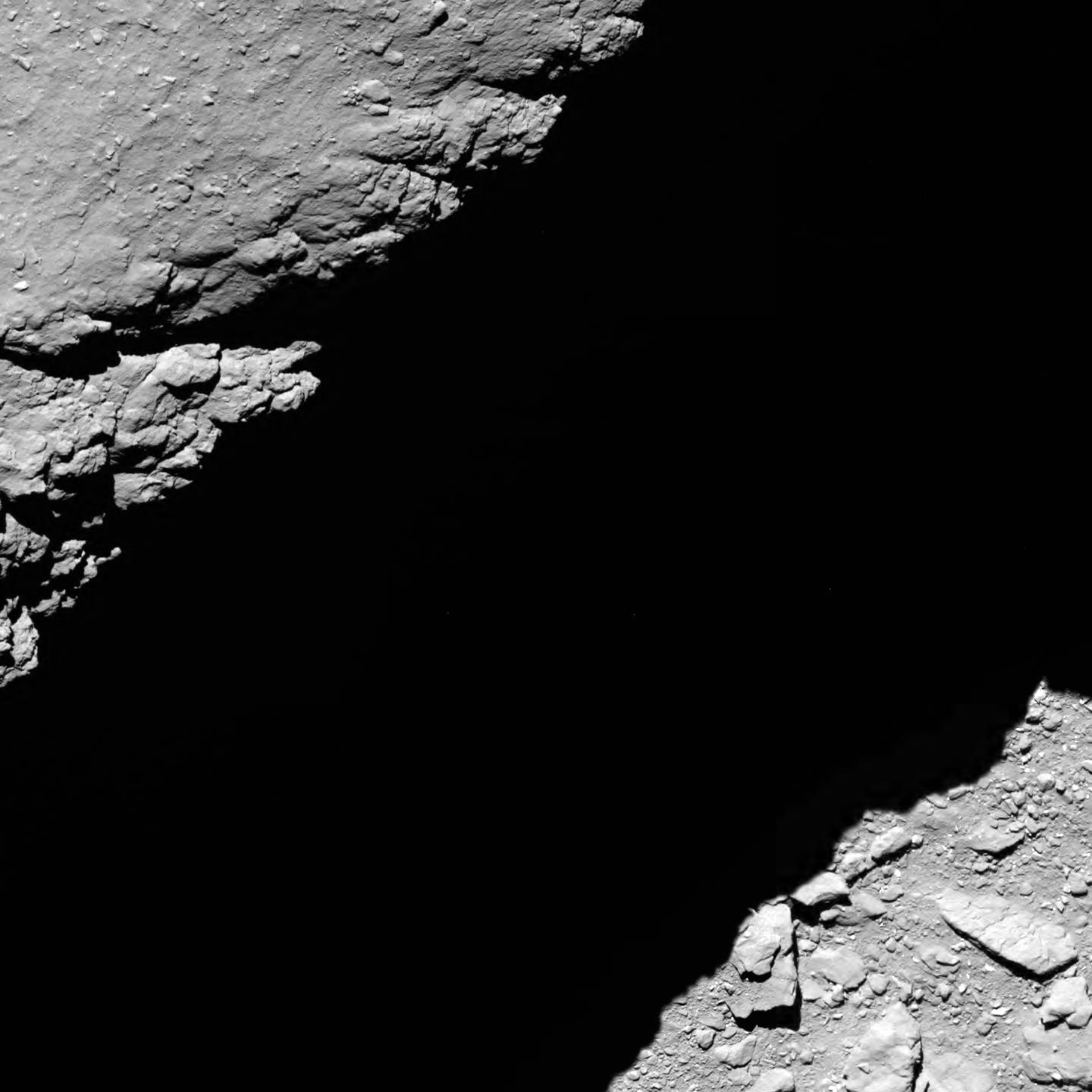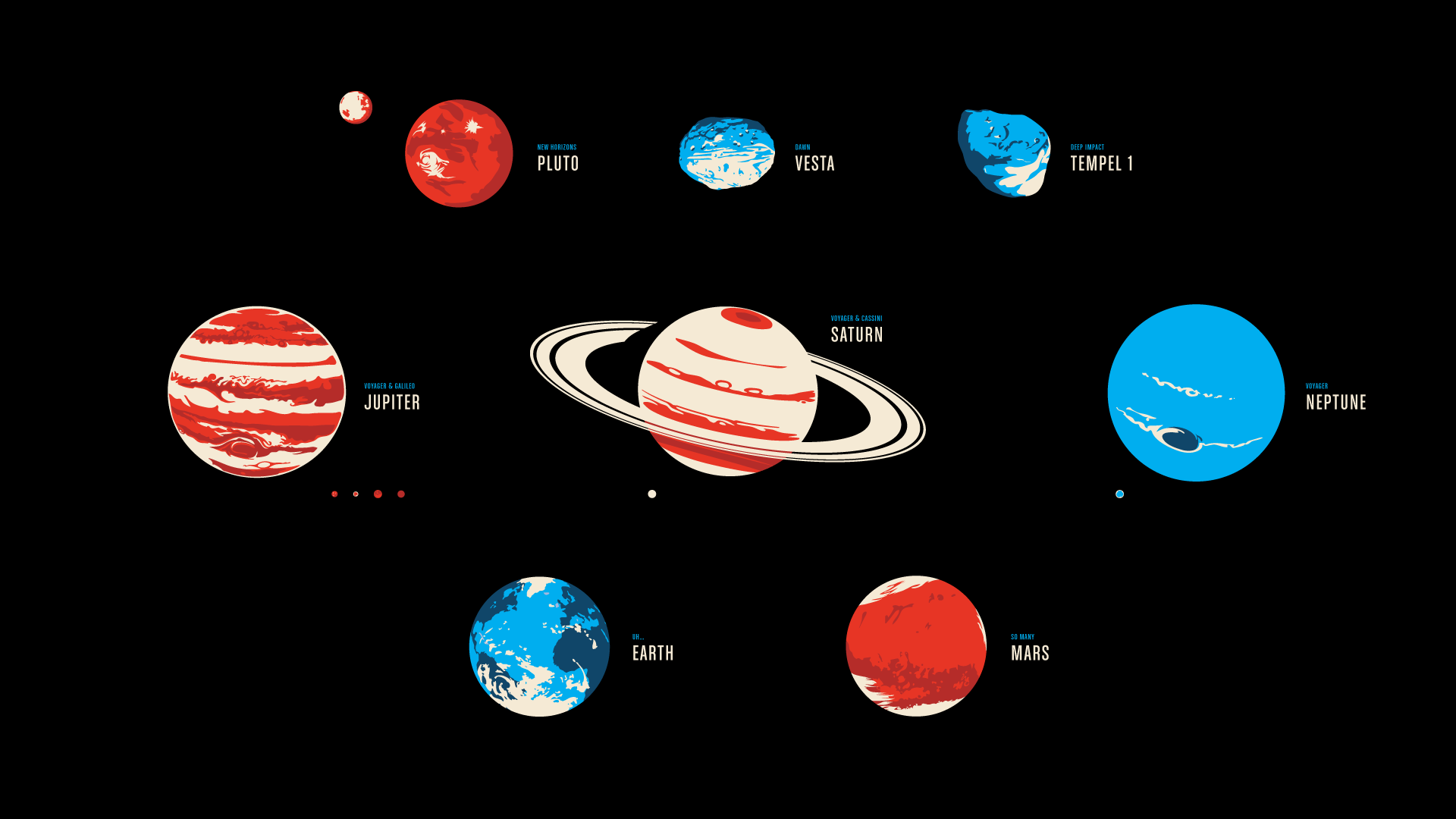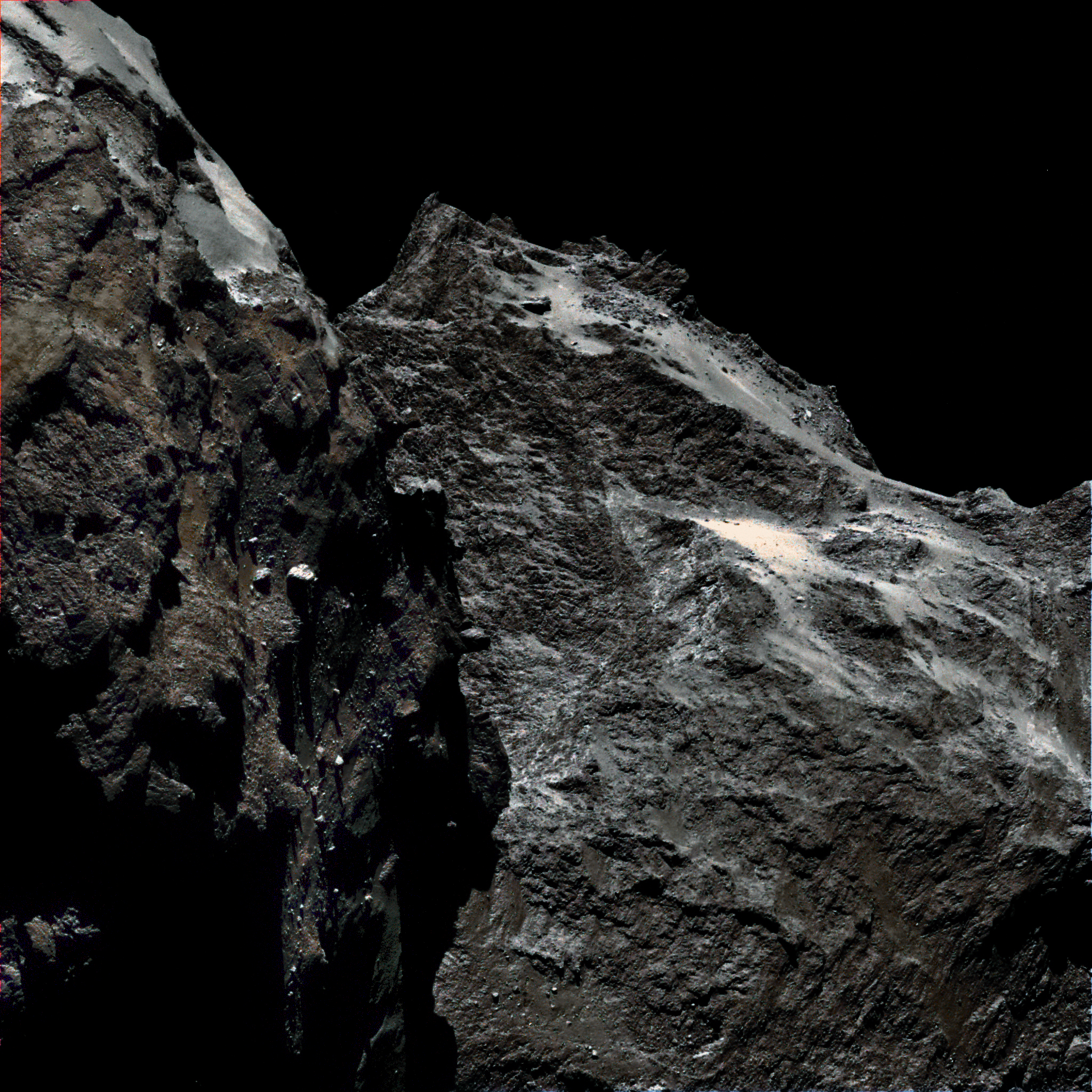“Here's a view of Saturn's moon Prometheus, made from images captured with the narrow-angle camera on Cassini on December 6, 2015. Cassini was about 37,400 km from Prometheus when the images were acquired. Part of the F ring is visible in the background at the top.” — Jason Major
Saturn Family Portrait
From planetary.org: On July 29, 2011, Cassini captured five of Saturn’s moons in a single frame with its narrow-angle camera: Janus, Pandora, Enceladus, Rhea, and Mimas. NASA/JPL-Caltech/Space Science Institute. This is a full-color look at a view that was originally published in September 2011.
COMET 67P/CG ANIMATED FROM ROSETTA STILLS
Hit play.
OSIRIS-REX Leaves Bennu
The OSIRIS-REX mission in on a two year trajectory back to Earth after capturing fragments of the near Earth asteroid Bennu after successfully executing a sample touchdown last fall. [LINK]
The sampling of of the asteroid’s surface is shown above.
Phobos over mount Sharp
Taken by the Curiosity rover. This is one of Mars tiny moons as seen from the ground. Impressive as it is only 14 long and you can actually see its shape from the surface. See Phobos below for reference.
Asteroid Bennu Is Active?!
Take a look at this image of Bennu and notice the material being ejected from the surface in the middle of the image. We are seeing an extremely rare “active” asteroid for the first time up-close. According to Dante Lauretta of the University of Arizona, "probably the biggest surprise of the early stages of the OSIRIS-REx mission and, I would say, one of the biggest surprises of my scientific career".
Since Osiris-Rex’s arrival in January this kind of event has been observed at least eleven times with three of events ejecting over 100 observable particles. There is no official theory as to the cause, but they suggest that these particles ultimately go into orbit for a spell and eventually return to the surface of Bennu. Which explains why after billions of years the rock hasn’t whittled away to nothing.
A Most Distant Encounter
Still waiting on better images from the Ultima Thule flyby on New Years Eve. Above is the best of just two images shared so far from the encounter. Below is a true-color attempt by Wildespace on unmannedspaceflight.com.
Profile of Comet 67P/Churyumov-Gerasimenko
Nice profile image of Comet 67P/Churyumov-Gerasimenko posted by jccwrt on twitter.
Two Rovers Dropped on Ryugu by Hayabusa 2
Closest Look Yet at Occator Crater, Ceres
Occator Crater is the mesa or large butte with a flat top located in the lower right hand corner of the image. It has been puzzling scientists since Dawn approached Ceres because its brightness was so intense that people were speculating if light could somehow actually be emanating from within the body. Many details are now visible in the boundaries between the bright and dark material but it is not yet clear if the lines are runoff, splatter or some other process yet to be understood.
Most Incredible REAL Video From the Surface of a Comet
The short clip compresses 25 minutes of images taken by the Philae Lander as it came to rest on the surface of Comet 67P/Churyumov–Gerasimenko. There is more going on in the image than you would think. Much of the dust that appears to be falling straight down are actually stars moving as 67P rotates. The dust that is actually moving in the image travels in all directions and mostly upward.
Image by @landru79 (who just won the internet). Be sure to see this page on LiveScience that explains how the clip was made and also includes an animation isolating the stars so you can see what is actually moving on the surface.
Rosetta’s Goodbye Landing
All images were taken from under 10km as Rosetta approached the surface.
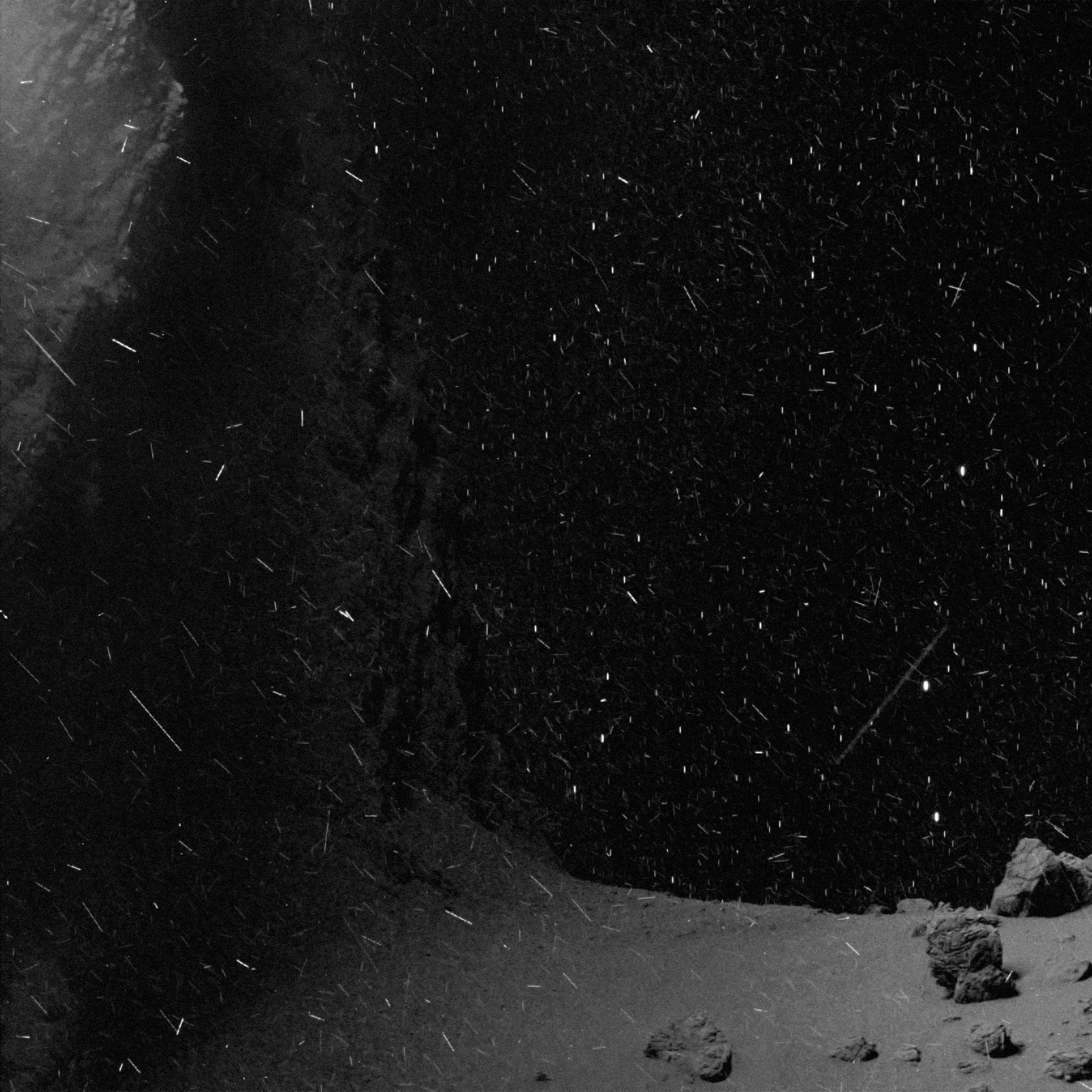
This first image was manipulated to reduce noise and increase contrast. What we see here is cometary dust particles moving in varied directions and lengths. Check out this animated GIF sent to me by Phil Stooke showing cometary dust moving around 67-P.
Cyber Tuesday Spaceprobe Deal
 For two days only, buy one of our limited edition Robotic Spacecraft Series Prints and get the full suite of vinyl stickers for free. This is a total savings of $24 and would serve as a great stocking stuffer to follow the presentation of the print.
For two days only, buy one of our limited edition Robotic Spacecraft Series Prints and get the full suite of vinyl stickers for free. This is a total savings of $24 and would serve as a great stocking stuffer to follow the presentation of the print.
Ceres Bright Spots Still Unknown
 Still — as close as this is, the nature of these spots are unknown. Must… get… closer… Read more.
Still — as close as this is, the nature of these spots are unknown. Must… get… closer… Read more.
The Surface of a Comet
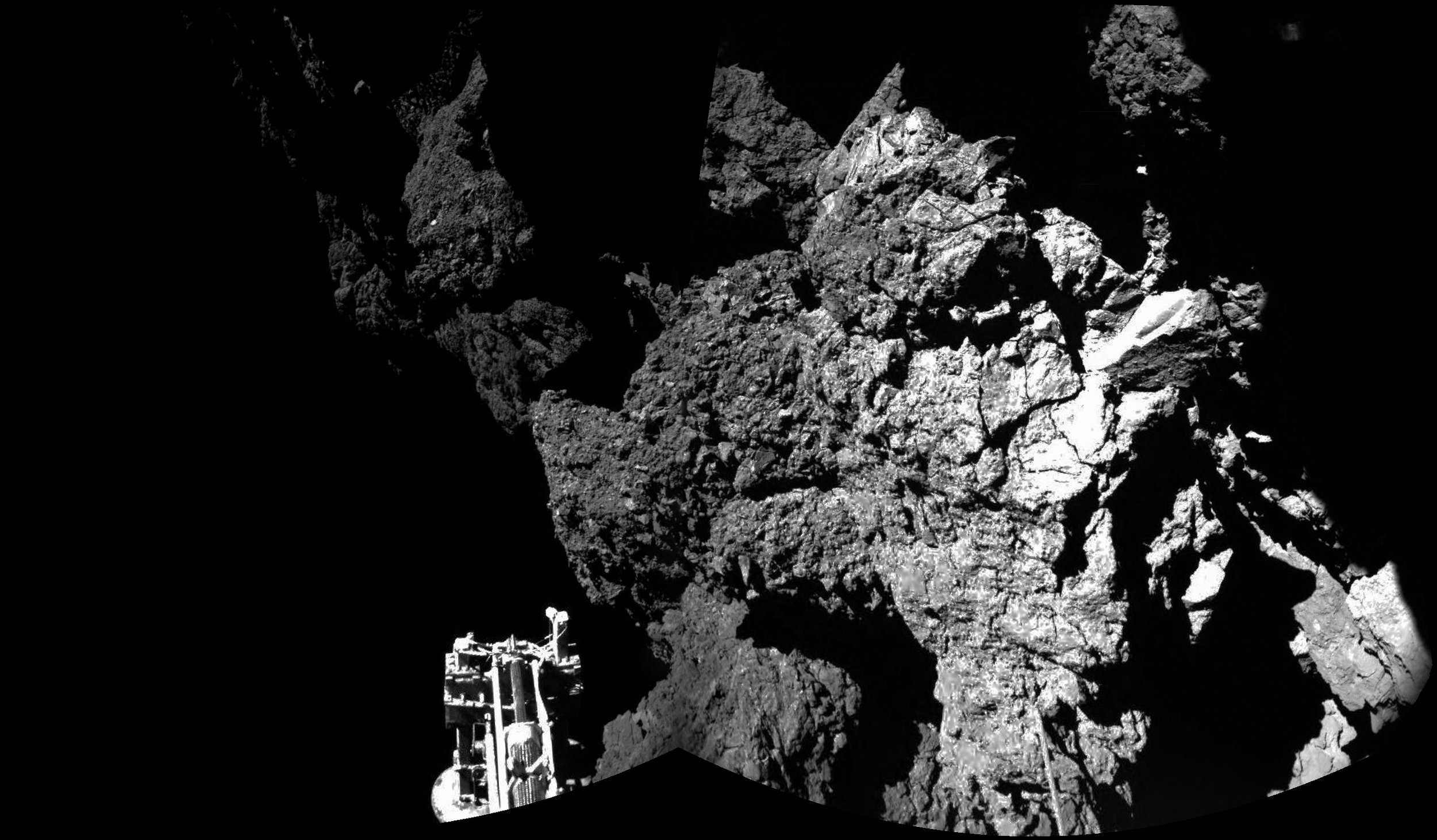 This was the view from Rosetta’s Philae lander when it came to rest upon Comet Churyumov-Gerasimenko. What is shown is one of the landers feet (bottom center) and a very craggy surface beyond. After bouncing 3-4 times, scientists assume that Philae finally came to rest set precariously upon an uneven surface. Despite these images and images taken from Rosetta orbiting above — they have yet to find exactly where the lander has settled.
This was the view from Rosetta’s Philae lander when it came to rest upon Comet Churyumov-Gerasimenko. What is shown is one of the landers feet (bottom center) and a very craggy surface beyond. After bouncing 3-4 times, scientists assume that Philae finally came to rest set precariously upon an uneven surface. Despite these images and images taken from Rosetta orbiting above — they have yet to find exactly where the lander has settled.
Shown above is the small journey Rosetta took before resting in a spot that has yet to be defined. Clearly shown are the mid-bounce images of the probe as it tumbled to its destination. Soon after these events the probe went silent due to a lack of power source: sunlight. It is thought that the probe may be covered in comet dust or simply sitting in a semi-permanently shaded spot unable to wake up.
On the bright side, even if this is all we hear from Philae — the mission is considered a successful landing as it did manage to transmit data and images from the surface. On an even brighter side… Mission specialists say that as the comet gets nearer to the sun and parts of whatever is hiding the probe melts away, could expose it’s starving solar panels and wake the probe up again renewed. Meaning that we could hear again from the small lander come this August.
Malmer’s Model
 It is hard to imagine that this is a 3D model by Matthias Malmer. Not a series of 120 images released by the Rosetta team and stitched into a movie, but rendered from just 4 images. I processed this quick animated gif and looking at the individual frames, cannot detect the difference between the individual frames and still images taken by Rosetta.
It is hard to imagine that this is a 3D model by Matthias Malmer. Not a series of 120 images released by the Rosetta team and stitched into a movie, but rendered from just 4 images. I processed this quick animated gif and looking at the individual frames, cannot detect the difference between the individual frames and still images taken by Rosetta.
Kickstarter Project Coming Oct 2
Two Amazing Images of Comet 67P/CG
 A new imager turning out some impressive work on the Rosetta mission has popped up on flickr. These are not only gorgeous, but are the first color images I have seen of the comet thus far. Check out 2di7 & titanio44’s image feed and see not only more color images of the comet Churyumov-Gerasimenko, but also great work done at Mars and Saturn as well.
A new imager turning out some impressive work on the Rosetta mission has popped up on flickr. These are not only gorgeous, but are the first color images I have seen of the comet thus far. Check out 2di7 & titanio44’s image feed and see not only more color images of the comet Churyumov-Gerasimenko, but also great work done at Mars and Saturn as well.
Image Notes: The original of the first image above can be seen here. What is posted here was cleaned up a bit by wanderingspace.net and is not intended for scientific use. We did the best to represent what is in the original, but telling the difference between what might have been boulders and what was image noise is hard to determine. Also, the jets were reprocessed and altered to appear smooth in this final version. More on the color below.
Image Notes: According to the imagers, there have been no filtered images released as of this date of Comet 67P/CG. Which means that the color above is artistic interpretation. Strikingly real looking, but still just a make-shift approach to consider what the color might be before any real data on color has been released by ESA.
Rosetta Selfie
 With the term “selfie” trending the way it is in popular culture… it was wise for the people at ESA to try a robotic interplanetary version. This image was shot by the Philae lander (still attached to Rosetta) staring down one of Rosetta’s solar panels looking at comet 67P/C-G in not-too-far-off distance.
With the term “selfie” trending the way it is in popular culture… it was wise for the people at ESA to try a robotic interplanetary version. This image was shot by the Philae lander (still attached to Rosetta) staring down one of Rosetta’s solar panels looking at comet 67P/C-G in not-too-far-off distance.
Worth noting this similarly happened here at Mars in 2007.
When It’s a Jet, It’s a Jet All the Way
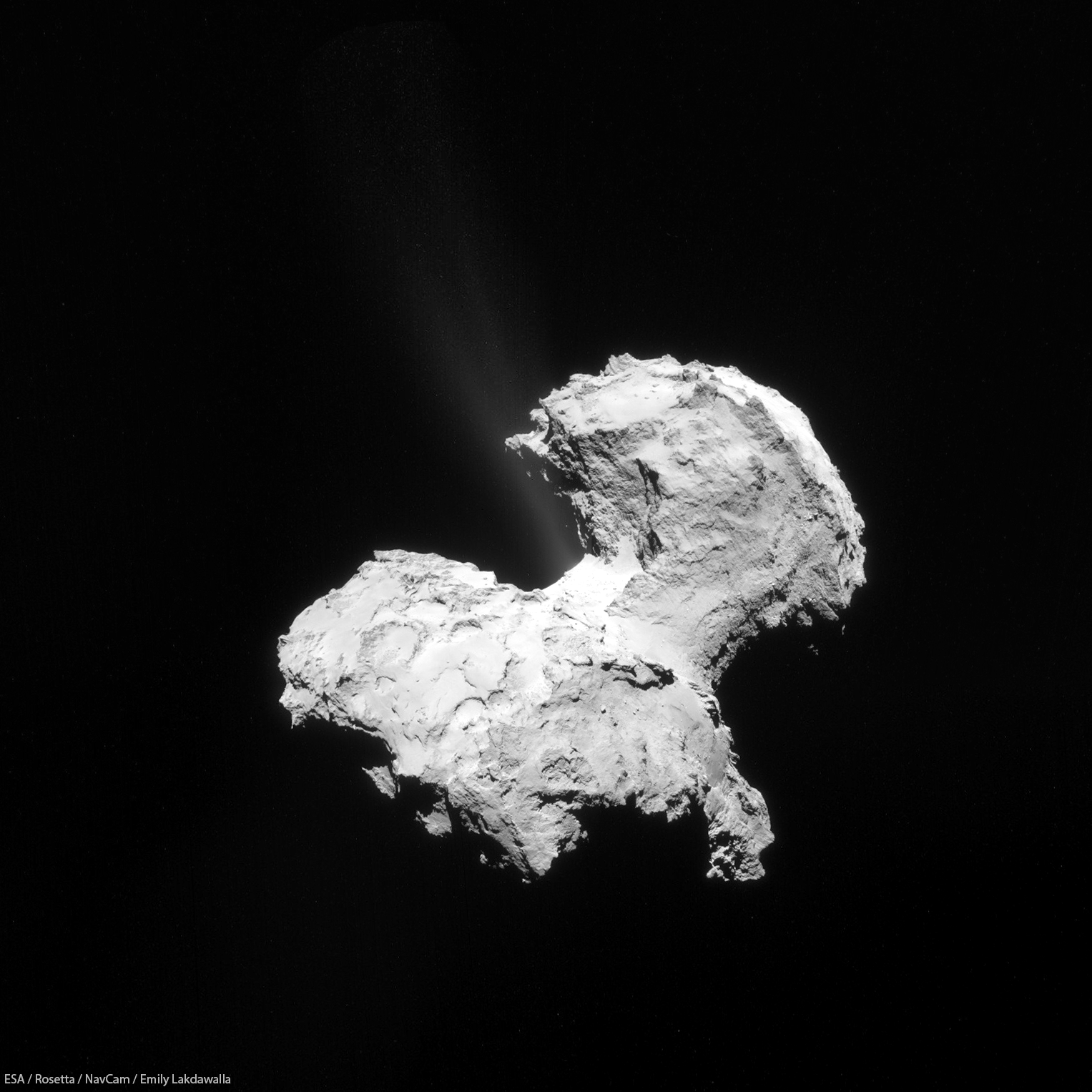 Comet Churyumov-Gerasimenko (aka CG-67P) is showing the early formation of it’s jets. Those jets are what cause the formation of the most distinguishing characteristic of any comet — it’s tail. The Rosetta spacecraft is currently in orbit about the comet and it is assumed that as the pair orbit closer to the sun, these jets will become much more active and should provide quite a show for us. The Rosetta team has also recently shared the potential landing sites for it’s Philae Lander in November shown here.
Comet Churyumov-Gerasimenko (aka CG-67P) is showing the early formation of it’s jets. Those jets are what cause the formation of the most distinguishing characteristic of any comet — it’s tail. The Rosetta spacecraft is currently in orbit about the comet and it is assumed that as the pair orbit closer to the sun, these jets will become much more active and should provide quite a show for us. The Rosetta team has also recently shared the potential landing sites for it’s Philae Lander in November shown here.
This image was brought to the world by Emily Lackdawalla’s Planetary Blog.

